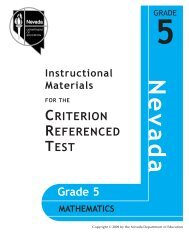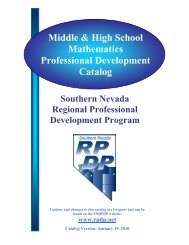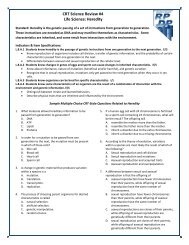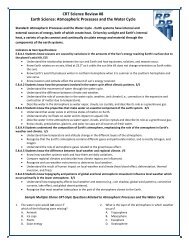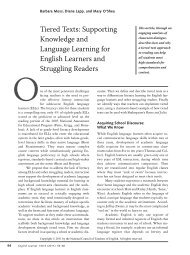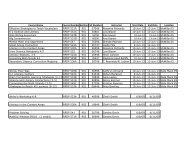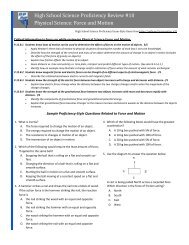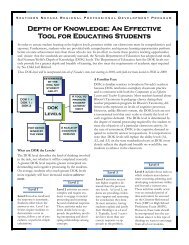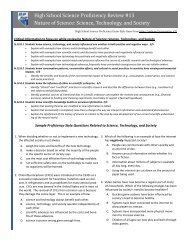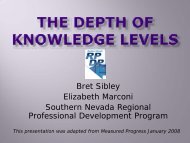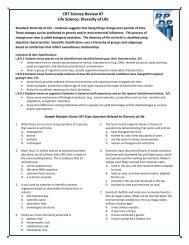Science Achievement Indicators Grade 6-8 - RPDP
Science Achievement Indicators Grade 6-8 - RPDP
Science Achievement Indicators Grade 6-8 - RPDP
Create successful ePaper yourself
Turn your PDF publications into a flip-book with our unique Google optimized e-Paper software.
<strong>Achievement</strong> <strong>Indicators</strong> for <strong>Science</strong><br />
<strong>Grade</strong>s 6-8<br />
Content Standard<br />
E.8.B.1 Students know the<br />
universe contains many billions<br />
of galaxies, and each galaxy<br />
contains many billions of stars.<br />
Content Standard E8B<br />
Students understand characteristics of our solar system that is part of the Milky Way galaxy.<br />
Work at the Emergent/ Work at the Approaches level Work at the Meets level<br />
Developing level may indicate may indicate ability to… demonstrates ability to…<br />
ability to…<br />
describe planets and stars.<br />
(E.8.B.1, E.8.B.2)<br />
explain that stars are like our<br />
Sun, but they are so far away<br />
that they look like points of<br />
light. (E.8.B.1, E.8.B.5,<br />
E.8.B.6)<br />
describe that there are many<br />
more stars than can be seen by<br />
the unaided eye. (E.8.B.1)<br />
describe that stars have<br />
different colors and brightness.<br />
(E.8.B.1)<br />
recognize that the universe<br />
contains many galaxies, each<br />
containing billions of stars.<br />
(E.8.B.1)<br />
Work at the Exceeds level<br />
demonstrates ability to…<br />
E.8.B.2 Students know the solar<br />
system includes a variety of<br />
planetary moons, asteroids, and<br />
comets.<br />
identify the solar system.<br />
(E.8.B.2, E.8.B.3, E.8.B.4)<br />
describe Earth as part of the<br />
Solar System. (E.8.B.2)<br />
model our Solar System.<br />
(E.8.B.2)<br />
describe the differences among<br />
the Sun, planets, moons,<br />
asteroids, and comets. (E.8.B.2)<br />
describe the formation of the<br />
Sun and Solar System using<br />
evidence from available<br />
models. (E.8.B.2)<br />
E.8.B.3 Students know<br />
characteristics of the planets of<br />
our solar system.<br />
recognize that the moon reflects<br />
light from the Sun. (E.8.B.2,<br />
E.8.B.3, E.8.B.7)<br />
explain that the moon reflects<br />
the Sun’s light. (E.8.B.2,<br />
E.8.B.3)<br />
recognize that there are planets,<br />
moons, asteroids, and comets in<br />
the Solar System. (E.8.B.2)<br />
compare the characteristics of<br />
planets in our Solar System.<br />
(E.8.B.3)<br />
compare the daytime/nighttime<br />
cycles and years for various<br />
planets in the Solar System.<br />
(E.8.B.3)<br />
August 2007 22



